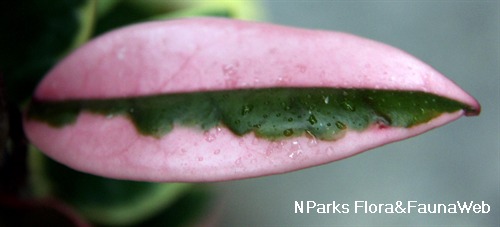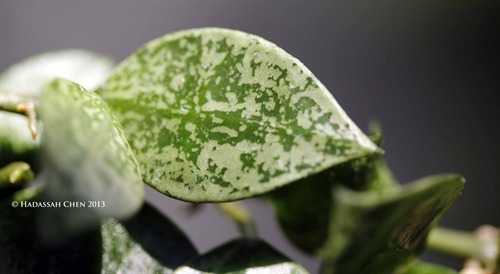.jpg)
Name
Classifications and Characteristics
| Plant Division | Angiosperms (Flowering Seed Plants) |
|---|---|
| Plant Growth Form | Climber |
| Lifespan (in Singapore) | Perennial |
| Mode of Nutrition | Autotrophic |
Biogeography
| Native Distribution | Indonesia, Philippines, Thailand, Borneo. |
|---|---|
| Native Habitat | Terrestrial |
| Preferred Climate Zone | Tropical |
| Local Conservation Status | Non-native (Horticultural / Cultivated Only) |
Description and Ethnobotany
| Growth Form | An epiphytic shrub which can grow up to 2.5 m tall. |
|---|---|
| Foliage | Leaf blade is elliptic, measuring 12 - 20 cm x 2 - 7 cm, base cuneate and apex acuminate, with pinnate venation. Petiole is 1 - 2 cm long. |
| Stems | Stems can be erect or decumbent, pale grey in colour, but turn yellowish when dry with persistent leaf scars. |
| Flowers | Flowers are borne on clusters, 20 - 50 flowers per cluster, which has short peduncle of 2 - 5 cm long. Sweet-scented the flower is 1.5 - 2.5 cm in diameter, with reflexed white to cream corolla lobes and yellow to pale orange apices. |
| Fruit | Fruit is linear, around 20 cm long and 6 mm wide. |
| Habitat | It is found growing as epiphytes on trees in lowland, and hilly mixed dipterocarp forests, mangroves and limestone forest. |
| Similar | Can be distinguished from other Hoya species by having a shrub growth habit, with a very distinct 'shooting-star' like flowers. |
| Etymology | The genus Hoya is named for wax flower. The specific epithet multiflora means many-flowered, which refers to the large number of flowers, often 30 - 40 per inflorescence. |
Landscaping Features
| Desirable Plant Features | Ornamental Flowers, Fragrant (Flowers) |
|---|---|
| Landscape Uses | Suitable for Hanging Baskets, Interiorscape/ Indoor Plant, Small Gardens |
Plant Care and Propagation
| Light Preference | Semi-Shade |
|---|---|
| Water Preference | Little Water |
| Plant Growth Rate | Fast to Moderate |
| Rootzone Tolerance | Moist Soils, Well-Drained Soils |
| Potential Problems | No serious pests or disease problems. |
| Propagation Method | Stem Cutting |
Foliar
| Foliage Retention | Evergreen |
|---|---|
| Mature Foliage Colour(s) | Green |
| Mature Foliage Texture(s) | Smooth, Thick |
| Prominent Young Flush Colour(s) | Green |
| Foliar Type | Simple / Unifoliate |
| Foliar Venation | Pinnate / Net |
| Foliar Margin | Entire |
| Foliar Apex - Tip | Acute |
| Foliar Base | Cuneate |
Floral (Angiosperm)
| Flower & Plant Sexuality | Bisexual Flowers |
| Flower Colour(s) | White, Yellow / Golden |
|---|---|
| Flower Grouping | Cluster / Inflorescence |
| Flower Location | Axillary, Terminal |
| Flower Symmetry | Radial |
| Individual Flower Shape | Stellate / Star-shaped |
| Inflorescence Type | Umbel |
| Flowering Period | Free-Flowering |
Image Repository
Others
| Master ID | 120 |
|---|---|
| Species ID | 1416 |
| Flora Disclaimer | The information in this website has been compiled from reliable sources, such as reference works on medicinal plants. It is not a substitute for medical advice or treatment and NParks does not purport to provide any medical advice. Readers should always consult his/her physician before using or consuming a plant for medicinal purposes. |

.jpg)
.jpg)
.jpg)





